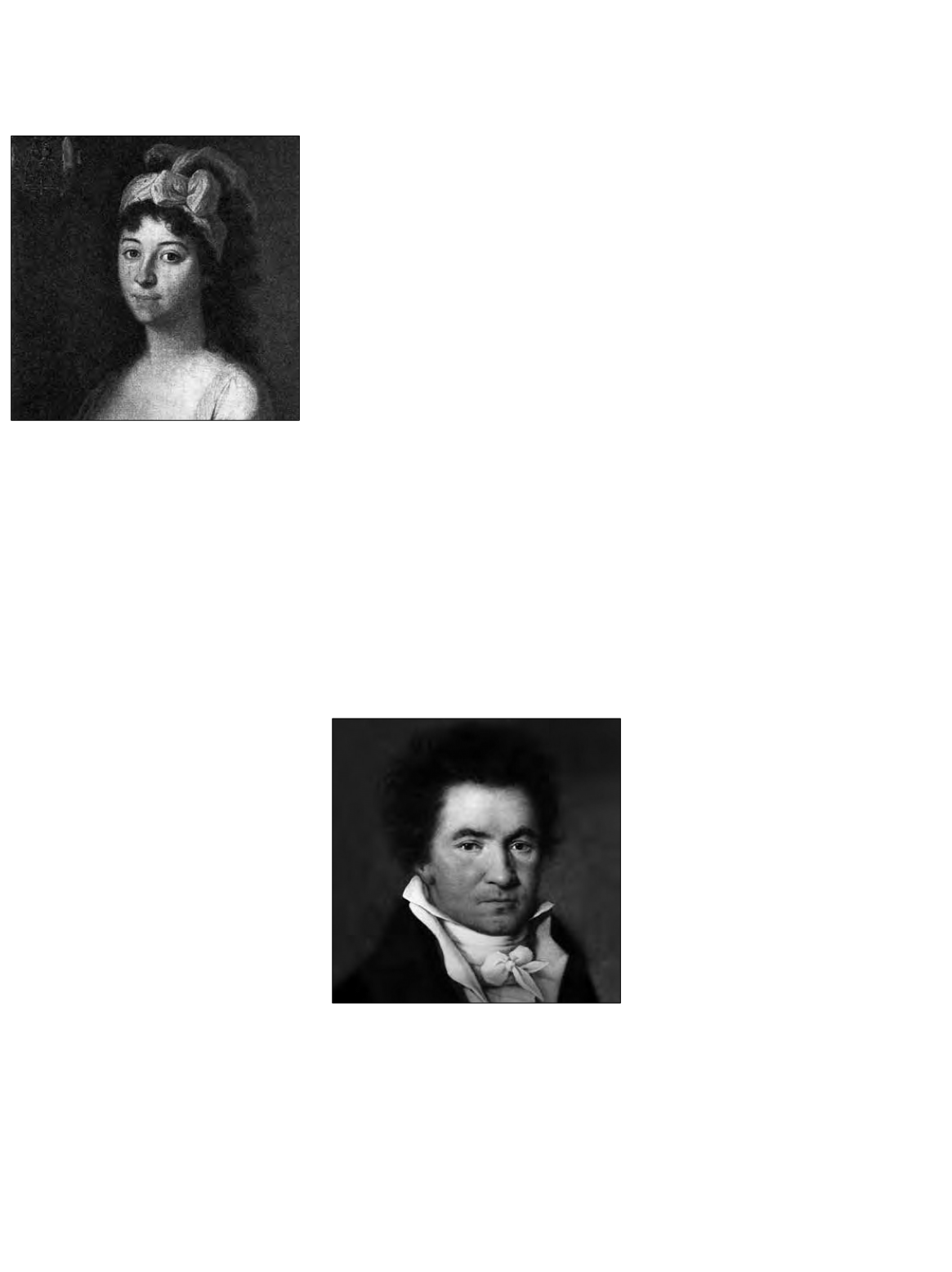

more circumspect and intelligent, particularly
in regard to the productions of younger com-
posers.” With concertos, newer meant better in
Beethoven’s mind. Clearly, the effectiveness of
these six-year-old concertos had passed.
Beethoven’s interest in motivic expansion is al-
ready apparent at this early stage in his composi-
tional career. The initial theme of the
Allegro con
brio
contains an octave leap and rocketing scale
pattern. The key of C major typically prompts
military associations, but Beethoven delays the
expected loud outburst until the second set
of phrases. (Mozart similarly postponed the
martial element in his Piano Concerto No. 21
in C major, K. 467.) Several transitional ideas
instill energy that is dissipated with a tender
E-flat-major violin melody. Beethoven allows
vigorous closing material to out-proportion the
more stable main themes. The piano finally en-
ters, presenting a new, unaccompanied theme.
Orchestral interjections hearken back to the
opening motives, around which the solo in-
strument weaves brilliant countermelodies. Ob-
serving Mozartean convention, the piano and
orchestra progress through previously heard
themes. Development fuses the octave-leap
motive with grandiose piano figuration. The or-
chestra restates the two main themes, each time
echoed by the piano. Three cadenzas authored
by Beethoven exist for this movement.
The
Largo
contains spacious lyricism and a
palpitating accompaniment reminiscent of
the famous
Andante
from Mozart’s Concerto
No. 21 (used in the film
Elvira Madigan
). This
sprawling composition is uncharacteristically
long for Beethoven. However, his ability to sus-
tain a tranquil atmosphere throughout much of
the movement demonstrates the depth of Mo-
zart’s influence. The concerto concludes with a
zesty
Rondo
, whose refrain theme has origins
in a piano trio in E-flat major. Franz Wegeler
claimed that Beethoven completed the rondo
in haste on the Sunday before the premiere. The
refrain’s memorable tune tends to overshadow
several well-shaped themes that occur between
its statements. There are two cadenza passages—
one partly supported by orchestra, and the other
unaccompanied—that segue into the refrain.
Symphony No. 7 in A major, op. 92
Scored for two flutes, two oboes, two clarinets,
two bassoons, two horns, two trumpets, timpani,
and strings
Beethoven rode a wave of popularity into the
second decade of the 19th century. The trium-
phant spirit of the Viennese, undiminished
during the Napoleonic invasions, resounded in
his “heroic period” compositions. Beethoven’s
music was revered as a national treasure during
the Congress of Vienna (1814–15), whose as-
sembled monarchs sought to restore peace and
order in Europe. Kings, tsars, empresses, aris-
tocrats, and other notables paid homage to the
composer, if only for the moment.
Ironically, Beethoven expressed his patriotism
most often in cantatas and hymns, forms more
fashionable in Paris than in Vienna. There also
was
Wellington’s Victory
(also known as the “Bat-
tle Symphony”), originally for the panharmon-
icon, a mechanical organ by Johann Nepomuk
Maelzel, the inventor of the metronome. Bee-
thoven orchestrated this music in 1813. Pure
symphonic composition from this period was
reserved for broad sentiments, such as the grand
Romantic heroism of the Third (“Eroica”) and
Fifth, scenes of rural life in the Sixth (“Pasto-
ral”), and the Classicism of the Eighth and, to a
lesser degree, the Fourth.
The distinction between these nationalist, pasto-
ral, and heroic expressions was bridged, at least
in the minds of Beethoven’s contemporaries, in
the Seventh Symphony. Numerous program-
matic descriptions by other musicians soon ap-
peared in print. Beethoven railed against these
fanciful imaginings of battles, triumph over
oppression, drunken revelry, bucolic meadows,
and merrymaking. The music’s patriotic asso-
ciations, however, were almost impossible to
overlook.
Beethoven introduced the Symphony No. 7 to
the public at a benefit concert for Austrian and
Bavarian soldiers injured at the battle of Hanau.
This work was followed by two trifles by Dussek
and Pleyel for orchestra with the panharmon-
icon (Maelzel sponsored the concert), as well
as Beethoven’s
Wellington’s Victory
. This musical
celebration lifted battle-weary spirits and added
to the relief fund on the eve of the Congress of
Vienna.
Unusual collegiality among the Viennese mu-
sicians surrounded this concert. Ignaz Schup-
panzigh led the violins, while Ludwig Spohr and
Joseph Mayseder sat back in the section. The
percussionists included piano virtuoso Johann
Nepomuk Hummel and imperial Kapellmeis-
ter Antonio Salieri. The unified devotion of
the musicians impressed all who attended, and
both audience and critics accorded Beethoven’s
symphony special praise. The review in the
All-
gemeine Musikalische Zeitung
was effusive: “The
new symphony in particular fully deserved
the loud applause and the exceptionally warm
reception that greeted it. One must hear this
newest work of Beethoven’s genius as ably per-
formed as it was here to appreciate fully its beau-
ty and to enjoy it to the utmost. …The
Andante
[the second movement, later retitled
Allegretto
]
had to be repeated, and delighted musicians and
amateurs alike.”
The Symphony No. 7 in A major, op. 92—com-
posed in 1812 and 1813—begins with the most
expansive slow introduction of Beethoven’s
symphonic catalogue. Faster dance-like rhythms
prevail in the main portion of the movement.
Prominent writing for the winds lends a pasto-
ral atmosphere. A sustained chord in the winds
fades into the main theme of the
Allegretto
. At
first, the haunting melody appears in the low
strings. The theme gradually rises from the
depths of the orchestra in a series of variations,
each time outfitted with an expressive counter-
melody. Beethoven interjects a new melody in
the clarinet and bassoon midway through the
movement.
The
Presto
presents a frolicking staccato theme
that is twice interrupted by a rustic melody. Bi-
ographer Alexander Wheelock Thayer suggest-
ed that this theme was an actual Austrian pil-
grimage hymn. The finale is taut and propulsive;
spirited, almost militaristic, rhythmic patterns
unify this movement. Brass and timpani are em-
ployed to great effect. This rousing music pro-
vides a triumphant conclusion to the symphony.
–Program notes © 2018 Todd E. Sullivan
Countess Anna Luise Barbara d’Erba-Odescalchi
Ludwig van Beethoven by Joseph Willibrord Mähler
(1815)









